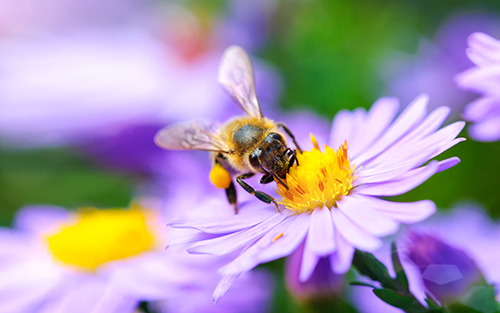Planting a Pollinator Garden
Apr 18, 2022

Did you know that over 75% of food crops grown in the U.S. depend on pollinators such as insects, reptiles, and birds? As we watch the honeybees buzz around our yard, it’s no wonder that we coined the term “busy bees!” These little pollinators have a big job to do.
Planting a pollinator garden is an easy way to support and maintain these animals by supplying them with a steady source of food in the form of pollen and nectar. You will not only attract bees, but butterflies, moths, and hummingbirds as well — a win-win for the environment. The size and plant variation of pollinator gardens can range from a large portion of your yard with a variety of pollinator-friendly plants to a small corner consisting of a select few most favored plants. Either way, any effort you can make to sustain our wild pollinators is a productive and beneficial undertaking for our environment.
Here are four things to consider when planning your pollinator garden:
Choose a sunny location
The plants and flowers that pollinators love the most tend to grow best with plenty of sunlight. Likewise, pollinators need the sun themselves to warm their bodies so that they can better fly. Avoid planting your garden in an area where the wind is funneled through, which can discourage pollinators from landing.
Offer a water source
Just like humans, pollinators get thirsty too. Provide a source of water near your gardens such as a birdbath or shallow bowl and place a few small rocks in the water to give bees and butterflies a place to land and rest. Because pollen and nectar don’t contain much moisture, this will ensure that your local pollinators stay healthy and safe.
Eliminate pesticides
The residue from pesticides left behind on the plant can harm pollinators when they ingest the contaminated pollen or nectar. For this reason, eliminate all use of pesticides around your pollinator habitat if possible. If you must use a pesticide, however, use the least-toxic material available and spray at night when bees and other pollinators are not as active.
Use a wide variety of plants
Although there is a multitude of plants that can be used in a pollinator garden, native plants are particularly desirable because they are already adapted to your local climate and soil. Choose a selection of plants and flowers that bloom from spring into early fall so that your pollinators stay happy all season long. Help pollinators find your garden by planting in clumps rather than spacing out single plants. And remember, not only are bright colors appealing to our human eyes, but they are also like magnets to pollinators, so get colorful!
Your local Co-op has everything you need to start your pollinator garden this spring from seeds and tools to expert advice.
For more content like this, check out the latest issue of the Cooperator.
Planting a pollinator garden is an easy way to support and maintain these animals by supplying them with a steady source of food in the form of pollen and nectar. You will not only attract bees, but butterflies, moths, and hummingbirds as well — a win-win for the environment. The size and plant variation of pollinator gardens can range from a large portion of your yard with a variety of pollinator-friendly plants to a small corner consisting of a select few most favored plants. Either way, any effort you can make to sustain our wild pollinators is a productive and beneficial undertaking for our environment.
Here are four things to consider when planning your pollinator garden:
Choose a sunny location
The plants and flowers that pollinators love the most tend to grow best with plenty of sunlight. Likewise, pollinators need the sun themselves to warm their bodies so that they can better fly. Avoid planting your garden in an area where the wind is funneled through, which can discourage pollinators from landing.
Offer a water source
Just like humans, pollinators get thirsty too. Provide a source of water near your gardens such as a birdbath or shallow bowl and place a few small rocks in the water to give bees and butterflies a place to land and rest. Because pollen and nectar don’t contain much moisture, this will ensure that your local pollinators stay healthy and safe.
Eliminate pesticides
The residue from pesticides left behind on the plant can harm pollinators when they ingest the contaminated pollen or nectar. For this reason, eliminate all use of pesticides around your pollinator habitat if possible. If you must use a pesticide, however, use the least-toxic material available and spray at night when bees and other pollinators are not as active.
Use a wide variety of plants
Although there is a multitude of plants that can be used in a pollinator garden, native plants are particularly desirable because they are already adapted to your local climate and soil. Choose a selection of plants and flowers that bloom from spring into early fall so that your pollinators stay happy all season long. Help pollinators find your garden by planting in clumps rather than spacing out single plants. And remember, not only are bright colors appealing to our human eyes, but they are also like magnets to pollinators, so get colorful!
Your local Co-op has everything you need to start your pollinator garden this spring from seeds and tools to expert advice.
For more content like this, check out the latest issue of the Cooperator.